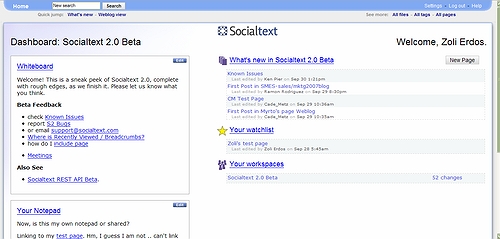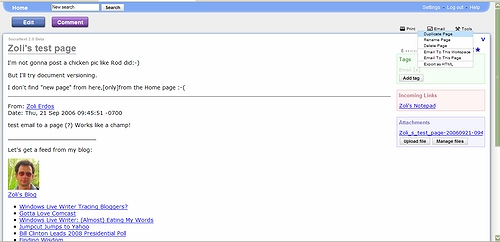 Google Groups has a new version: no, it’s not 2.0, it’s called – what a surprise – Google Groups Beta.
Google Groups has a new version: no, it’s not 2.0, it’s called – what a surprise – Google Groups Beta.
There are aesthetic as well as functional improvements. The appearance of individual Groups can be customized, one can pick from a dozen or so standard themes, upload a logo and change colors/fonts ..etc.
Most important are the functional improvements, first of all the Pages feature, which allows for easy collaboration, e.g. the editing of an article by group members using an easy, WYSIWYG-style editor. From the pages you can link to other pages or external sites. When you save your page, you can optionally notify group members, who can, depending on what access rules you set up (per page) read or edit it.
There is a new Files area, not too generous though, with a limit of 100MB – are we seeing signs of Freemium? Paying for storage wouldn’t be consistent with Google’s strategy, or at least what we’ve seen so far. Document versioning would be nice in the Files area (something I’ve ranted about recently).
The Members area allows the creation of fairly detailed profiles, with a photo and link to your own site/blog. It also provides statistics of your group activity.
None of the individual features are radically new; what’s nice is how they are wrapped together. To continue with my example of collaboratively editing an article, so far we could do it using a number of tools, like Google’s own Writely, or Zoho Writer, or a wiki, but the issue is how to share: specifically, who to share with. Most of these platforms would allow either public sharing, or inviting users individually, but there is no way to share such a document with a predefined set of users, i.e. members of my email group. Of course you could always opt for a complete solution, like Central Desktop, which has collaborative editing, groups, calendar, wiki, project management, tasks ..etc – but your have to pay for it.
Wrapping it up, in a major step forward, Google Groups which so far has been just a group email mechanism, becomes a mini community/collaborative platform, likely attracting previously “email-only” users to the native web-interface – and we all know why Google loves that.
Update (9/6): The revamped Google Groups fits very well Google’s new “Features, not products” initiative.


 The Home Page is of key importance in the new release: a Dashboard gives users a quick glance of a shared whiteboard, personal notepad, customizable watchlist, a listing of what’s new (i.e. recently changed pages) as well as the users active workspaces (i.e. wikis). The Home page has become the central place where you can access all extended features, like a listing of all pages, files, tags, or change settings. You can start adding information using the New Page button, which, just like the Edit and Comment buttons on all subsequent pages clearly stands out, again, passing the “blink test”. I love the new colored
The Home Page is of key importance in the new release: a Dashboard gives users a quick glance of a shared whiteboard, personal notepad, customizable watchlist, a listing of what’s new (i.e. recently changed pages) as well as the users active workspaces (i.e. wikis). The Home page has become the central place where you can access all extended features, like a listing of all pages, files, tags, or change settings. You can start adding information using the New Page button, which, just like the Edit and Comment buttons on all subsequent pages clearly stands out, again, passing the “blink test”. I love the new colored 
 We tend to think in structures, need organizing principles – there is a reason why books have a table of contents. Wikis, as unstructured as they are in “virgin state” are a good tool to create structure – our own one. The assumption of a parent-child relationship mimics our usual workflow, and it does not impose a rigid structure, since through through cross-linking we can still have alternate structures, no matter where we create a page.
We tend to think in structures, need organizing principles – there is a reason why books have a table of contents. Wikis, as unstructured as they are in “virgin state” are a good tool to create structure – our own one. The assumption of a parent-child relationship mimics our usual workflow, and it does not impose a rigid structure, since through through cross-linking we can still have alternate structures, no matter where we create a page.



Recent Comments